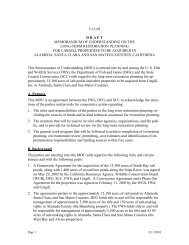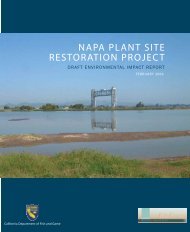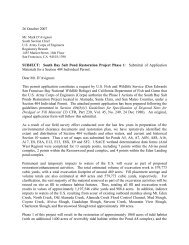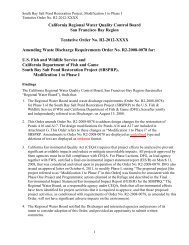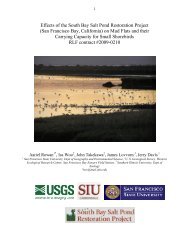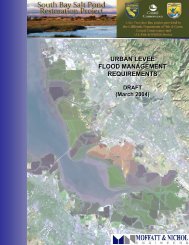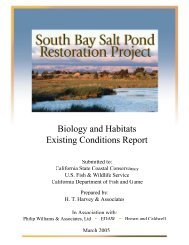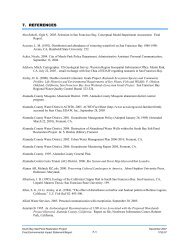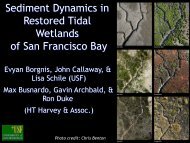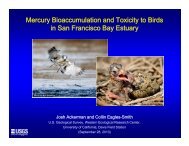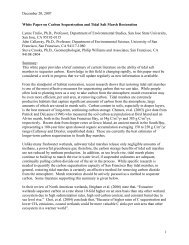M E M O R A N D U M - South Bay Salt Pond Restoration Project
M E M O R A N D U M - South Bay Salt Pond Restoration Project
M E M O R A N D U M - South Bay Salt Pond Restoration Project
Create successful ePaper yourself
Turn your PDF publications into a flip-book with our unique Google optimized e-Paper software.
• Consideration of how marsh/upland transition contributes to satisfying the evaluation criteria, as<br />
documented in the conceptual models for habitat restoration (in progress):<br />
- Transitional habitat provides high tide refuge for the mouse, contributing to survival<br />
- Transitional habitat is necessary for growth and survival of rare plants<br />
• Opportunities and Constraints (PWA and others 2004c)<br />
- Location of adjacent upland areas<br />
5. PRELIMINARY PROGRAM ALTERNATIVES<br />
The preliminary program alternatives are:<br />
• No Action Alternative<br />
• Alternative 1: Managed <strong>Pond</strong> Emphasis<br />
• Alternative 2: Mix of Managed <strong>Pond</strong> and Tidal Habitat<br />
• Alternative 3: Tidal Habitat Emphasis<br />
Each preliminary program alternative integrates habitat-restoration, flood-management, and public-access<br />
features for the three pond complexes, as shown in Figures 2 to 5. The No Action alternative is required<br />
for NEPA/CEQA compliance and represents the most likely condition in the absence of a long-term<br />
restoration plan. The three “action” alternatives provide for a mix of managed pond and tidal habitat, but<br />
vary in the relative extents of these habitats. The mix of habitats would benefit a variety of wildlife,<br />
including special-status species and migratory birds, and would increase the abundance and diversity of<br />
native species in the <strong>South</strong> <strong>Bay</strong>. Alternatives 1 through 3 all improve existing levels of flood protection<br />
and provide high quality public access and recreation opportunities.<br />
The variation in relative extents of tidal and managed pond habitat among the three project alternatives<br />
will allow the project to consider trade offs between project objectives that respond differently to one type<br />
of habitat versus another. The landscape-scale assessment, in progress and described in the ADF (PWA<br />
and others 2004a), will help inform this consideration of trade offs by increasing the level of<br />
understanding of sediment availability and bird use. Uncertainties about sediment availability affect our<br />
ability to know where and to what extent tidal marsh can be restored, as well as how much existing and<br />
created mudflats there will be following project implementation. Uncertainties about bird use affect our<br />
ability to know the extent of managed pond, mudflat, tidal marsh, and bay habitat required to maintain<br />
current migratory bird species that use the <strong>South</strong> <strong>Bay</strong>. The adaptive management program (Section 7)<br />
will be important in further improving understanding (and reducing uncertainty) as the project is<br />
implemented.<br />
Alternatives 1 to 3 all include at least 10% reconfigured pond habitat, with the exact locations within the<br />
designated managed pond areas to be determined during the planning process. To maintain current<br />
populations of bird species breeding in the ponds 2 , it is likely that at least 10% of the existing salt pond<br />
area (i.e., approximately 1,500 acres) will need to be managed as reconfigured ponds for nesting. This<br />
2 Evaluation criteria for project objective 1b, see the Alternatives Development Framework (PWA and others 2004a)<br />
<strong>South</strong> <strong>Bay</strong> <strong>Salt</strong> <strong>Pond</strong> <strong>Restoration</strong> <strong>Project</strong> January 2005<br />
Preliminary <strong>Project</strong> Alternatives Memorandum 13 1750.01





